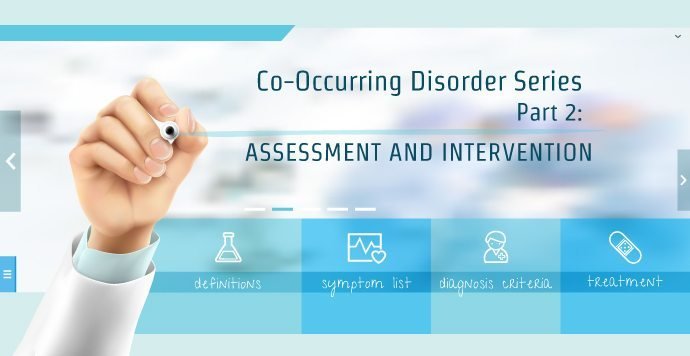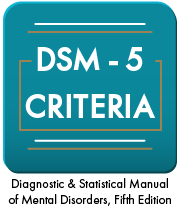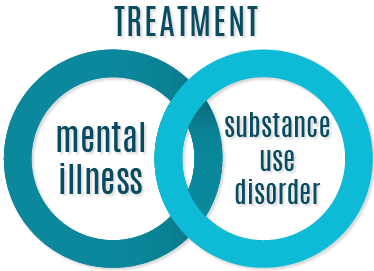Co-Occurring Disorder Series Part 2: Assessment and Intervention

In the first article in this miniseries, I talked about some of the statistics of a co-occurring disorder, or a substance use disorder (SUD) and a diagnosable mental illness. I also shared the symptoms that need to be seen, per the DSM 5, in order to diagnose someone with an SUD, as well as the diagnostic criteria for diagnosing someone with a major depressive disorder (MDD). I chose to start out talking about MDD first since it ranks as one of the most common of the mental illnesses, and often plays a large part in someone’s use of substances, addictions, and potential relapses. In here I will talk more about the nuts and bolts of getting help, the assessment process and some of the ways to get help.
Assessment
 I said in the above paragraph that it is an “assessment process” meaning it may take more than one meeting, however lengthy that may be, to actually get to know the person and what is truly going on for him or her. One of the first things to consider when trying to assess an individual, especially one with a SUD and potential mental illness as well, is what is a result of substance use and what is a result of mental illness. This part is tricky sometimes, I will admit. Some medications will quite convincingly mimic a mental illness. One ubiquitous example is alcohol being a well-known depressant that can cause depressed or sad mood, lethargy, irritability, lack of caring about self and normal interests; if you go back to the previous article, you will see how strikingly that mirrors the symptomology of MDD. This gets complicated by the detox process, as some substances will have longer ranging impacts on the mind and body than just a couple days.
I said in the above paragraph that it is an “assessment process” meaning it may take more than one meeting, however lengthy that may be, to actually get to know the person and what is truly going on for him or her. One of the first things to consider when trying to assess an individual, especially one with a SUD and potential mental illness as well, is what is a result of substance use and what is a result of mental illness. This part is tricky sometimes, I will admit. Some medications will quite convincingly mimic a mental illness. One ubiquitous example is alcohol being a well-known depressant that can cause depressed or sad mood, lethargy, irritability, lack of caring about self and normal interests; if you go back to the previous article, you will see how strikingly that mirrors the symptomology of MDD. This gets complicated by the detox process, as some substances will have longer ranging impacts on the mind and body than just a couple days.
One very important way to try to parse this out is by talking with the person in question about life prior to use of substances. Having them talk at length about what they were like before addiction took hold of them can provide some good insight into what is addiction and what is, or may be, mental illness. Some who have a very lengthy history of SUD may struggle to remember those times, and if that is the case it is important to look at the times where the individual was clean and sober, and hear about that.
Another way to gather information for a diagnosis is a more controversial one. Sometimes family is going to be the best resource available to what the person is or was like when clean and sober. Why is this a more difficult way of gathering data? Simply put, it becomes a legal, ethical, and clinically practical line that the professionals involved have to walk, and it is hair fine. First it depends on what the client in question agrees to, as everything might end there if the client does not consent to family being interviewed as a part of treatment. Second it is important for professionals to be respectful of client’s confidentiality and well-being even if permission is given to bring family into the picture. Lastly, sometimes family are not in much better shape than the person in treatment; in other words, their recollection may be just as suspect as the client’s. But if it is possible, family can verify what the client has said, or can elaborate more, and provide what is needed to make a good and accurate diagnosis.
There are many, many assessment tools out there, for both SUD and MDD. For example, the MAST, Michigan Alcohol Screening Test, or the Beck Depression Inventory, are tests to take asking questions centered around common symptoms for SUD and MDD, and then they are scored by a professional with the score falling into one of several categories, correlating with a possible diagnosis. While these may not be 100% accurate 100% of the time, they can provide a starting point, or more evidence, for a diagnosis.
Treatment
 For a long time, treatment for a co-occurring disorder would be treated like this: first one set of professionals, often in substance abuse treatment, would define what their side of the problem was, and work with the client on that. Then the client would be transferred to another set of professionals, usually in mental health, would then define what their side of the problem is, and then treat that. Sounds complicated? Well it was. And still is to a large degree.
For a long time, treatment for a co-occurring disorder would be treated like this: first one set of professionals, often in substance abuse treatment, would define what their side of the problem was, and work with the client on that. Then the client would be transferred to another set of professionals, usually in mental health, would then define what their side of the problem is, and then treat that. Sounds complicated? Well it was. And still is to a large degree.
More and more research now is focused on combined treatment, where one professional is working with the client, treating all the problems together and simultaneously. While this may sound like a large job, and is in some ways, what is found is that problems are often all interconnected, and treating one problem has a tremendous impact on the others. In the first article, I wrote that conventional wisdom says that people with an SUD often self-medicate their problems or mental illnesses away; when this is the case, treating the mental illness often helps give relief to substance use, which lessens that particular problem. It is usually all connected in some way.
 Treatment strategies are also usually tailored to each individual, with specific goals and targets to meet. This should be one of the first steps in the treatment process. Having clear identifiable and agreed upon goals is a must; after all how do you know if you get where you are going if you do not know where that is? As far as therapies go, there are many choices available, and therapists will usually find a style they are good at, and work within that framework. Cognitive behavioral therapies are well tested for treating things such as depression and anxiety and used often for SUD as well. This involves identifying unhelpful, unhealthy, or unrealistic thoughts, and working actively to challenge and in a way debate and replace them with more helpful and accurate thoughts. It also involves identifying and changing behaviors that are also unhelpful or unhealthy, replacing them with behaviors that are healthy. Another choice would be a mindfulness based therapy, which involves some of the same strategies as cognitive therapy, but focuses also on tolerating distress, paying attention to oneself and reactions, being mindful and open to all options and choices not just the same ones that keep being repeated, and acceptance of what is and is not within a person’s power to change.
Treatment strategies are also usually tailored to each individual, with specific goals and targets to meet. This should be one of the first steps in the treatment process. Having clear identifiable and agreed upon goals is a must; after all how do you know if you get where you are going if you do not know where that is? As far as therapies go, there are many choices available, and therapists will usually find a style they are good at, and work within that framework. Cognitive behavioral therapies are well tested for treating things such as depression and anxiety and used often for SUD as well. This involves identifying unhelpful, unhealthy, or unrealistic thoughts, and working actively to challenge and in a way debate and replace them with more helpful and accurate thoughts. It also involves identifying and changing behaviors that are also unhelpful or unhealthy, replacing them with behaviors that are healthy. Another choice would be a mindfulness based therapy, which involves some of the same strategies as cognitive therapy, but focuses also on tolerating distress, paying attention to oneself and reactions, being mindful and open to all options and choices not just the same ones that keep being repeated, and acceptance of what is and is not within a person’s power to change.
 When dealing with mental illness, medication is often a topic that comes up. In the substance abuse field, some hold a view that says that a person needs to be off all substances that change their biochemistry, medication included. It may be useful to learn this before committing to any form of treatment. Personally, my view is if there is good reason to diagnose a person, and that diagnosis can be treated effectively and safely with medication, why let them suffer. Antidepressants are the most commonly prescribed medication in the country and among the safest as well. Other medications may be prescribed, for example to help with anxiety or sleep. It may only be a temporary course of treatment; frequently people just need to get their heads above water, for which medication is incredibly useful. Or for individuals with a biological basis for MDD, medication can be an important form of treatment.
When dealing with mental illness, medication is often a topic that comes up. In the substance abuse field, some hold a view that says that a person needs to be off all substances that change their biochemistry, medication included. It may be useful to learn this before committing to any form of treatment. Personally, my view is if there is good reason to diagnose a person, and that diagnosis can be treated effectively and safely with medication, why let them suffer. Antidepressants are the most commonly prescribed medication in the country and among the safest as well. Other medications may be prescribed, for example to help with anxiety or sleep. It may only be a temporary course of treatment; frequently people just need to get their heads above water, for which medication is incredibly useful. Or for individuals with a biological basis for MDD, medication can be an important form of treatment.
One final form of treatment takes the form of support. Support in SUD comes in the form of AA or NA, or any of the variations of 12 step programs that have grown over the years, for example Rational Recovery. For people with a co-occurring disorder, it is most helpful to go to 12 step or support group meetings that are focused on those having a mental illness and an SUD. The support, normalization, and comfort that comes with talking with one’s peers, without having to explain mental illness in an AA group, can provide some relief for people. A sponsor would be a specific person who is mentoring the individual in question about the support group and sober living, and will be a tremendous resource to use. Use that person! But it is also important to have other options for support, as a sponsor is not always available. Learn who can be called at 2am when things are getting difficult, and make a list of those people. Then find out what professional resources are available, for example crisis lines, drop in centers, internet chats or other support services that can be accessed. The key is to have people around that can be there when things are getting hard.
While this is a very brief overview of a therapist working with someone with SUD and MDD, the outline can give the average person an idea of what to expect in treatment. One simple way to look at treatment is the process of figuring out what is helpful, and learning to do more of that. It is surprising how hard that is for all of us. The next and final article in this series focusing on MDD will focus more on the loved ones of people with a co-occurring disorder, how to support them, and more importantly self-care during that.
Click Here To Read Co-Occurring Disorder Series: Understanding Depression and Substance Part 3: Helping Those We Love



 Resources about addiction and recovery
Resources about addiction and recovery
